Process for preparing contact lens with film by plasma enhanced chemical vapor deposition
a technology of chemical vapor deposition and contact lens, which is applied in the field of contact lens processing technology, can solve the problems of patient discomfort, patient resuscitation, and vision impairment, and achieve the effects of enhanced chemical vapor deposition, stable hydrophilicity and antifouling properties
- Summary
- Abstract
- Description
- Claims
- Application Information
AI Technical Summary
Benefits of technology
Problems solved by technology
Method used
Image
Examples
Embodiment Construction
[0030]Referring to FIGS. 1-4, a process for preparing contact lens with films by plasma enhanced chemical vapor deposition comprises the steps of:
[0031](A01) introducing hydrophilic functional groups on the contact lens 2 surface by using a plasma apparatus 1 to apply plasma modification on the surface of the contact lens 2 so as to form hydrophilic functional groups on the surface of the contact lens 2;
[0032](A02) respectively heating Poly (ethylene glycol) methacrylate (PEGMA) 4 and N-vinyl-2-pyrrolidone (NVP) 5 to default temperatures to transform Poly (ethylene glycol) methacrylate (PEGMA) 4 and N-vinyl-2-pyrrolidone (NVP) 5 into a gaseous state; and
[0033](A03) using the plasma apparatus 1 to deposit the gaseous Poly (ethylene glycol) methacrylate (PEGMA) 4 and N-vinyl-2-pyrrolidone (NVP) 5 on the plasma treated contact lens 2 by means of plasma enhanced chemical vapor deposition (PECVD) so as to form the thin film 22 on the surface of the plasma treated contact lens 2. The cont...
PUM
| Property | Measurement | Unit |
|---|---|---|
| pressure | aaaaa | aaaaa |
| pressure | aaaaa | aaaaa |
| temperatures | aaaaa | aaaaa |
Abstract
Description
Claims
Application Information
 Login to View More
Login to View More - R&D
- Intellectual Property
- Life Sciences
- Materials
- Tech Scout
- Unparalleled Data Quality
- Higher Quality Content
- 60% Fewer Hallucinations
Browse by: Latest US Patents, China's latest patents, Technical Efficacy Thesaurus, Application Domain, Technology Topic, Popular Technical Reports.
© 2025 PatSnap. All rights reserved.Legal|Privacy policy|Modern Slavery Act Transparency Statement|Sitemap|About US| Contact US: help@patsnap.com



